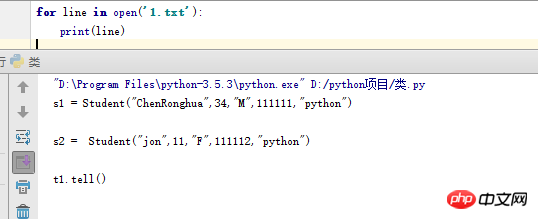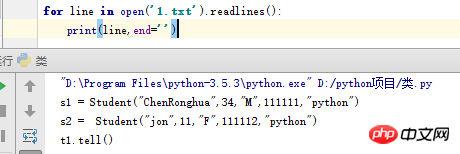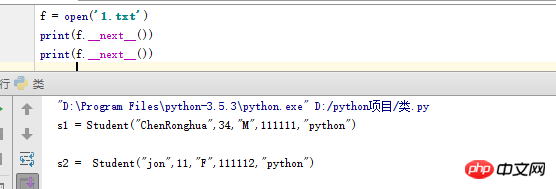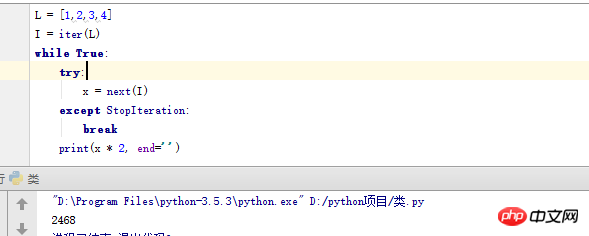 Backend Development
Backend Development
 Python Tutorial
Python Tutorial
 Easily confused concepts in Python-iterators and generators
Easily confused concepts in Python-iterators and generators
Easily confused concepts in Python-iterators and generators
Iterator and Generator
Iterator (iterator) and generator (generator) are two concepts that are commonly used and easily confused in Python. Today we will sort them out and give some commonly used ones. example.
for statement and iterable object:
for i in [1, 2, 3]:
print(i)
obj = {"a": 123, "b": 456}
for k in obj:
print(k)
These can The object used in the for statement to loop is an iterable object. In addition to the built-in data types (lists, tuples, strings, dictionaries, etc.) that can be iterated through the for statement, we can also create a container ourselves, containing a series of elements, and each element can be looped out sequentially through the for statement. This A container is an iterator.
The for loop can be used for any sequence type in python, including sequences, tuples and strings. For example:
>>> for x in [1,2,3,4]: print(x * 2,end='')
...
2468
>>> for x in (1,2,3,4): print(x * 2,end='')
...
2468
>>> for y in 'python': print(y * 2 ,end=' ')
...
pp yy tt hh oo nn
Actually, the for loop It's even more general than that: it can be used with any iterable object. You can think of for as an iteration tool, and there are some examples: list parsing, in membership testing, and map built-in functions.
File iterator
File has a method named __next__, which returns the next line in the file each time it is called. It is worth noting that when the end of the file is reached, __next__ will raise the built-in StopIteration exception instead of returning an empty string.
For example:

Note that the print here uses end='' to always add a \n, because the line string already has one (if not At this point, our output will become two lines separated),

There are three advantages to reading files in this way:
1. Simple writing
2. Fast running speed
3. It is also the best in terms of memory usage
The original method with the same effect is to call the readlines method of the file in a for loop , is to load the file into memory and make a list of line strings.

Although the two effects are the same, the latter loads the file into the memory at one time. If the file is too large, the computer memory space is not enough, and it may not even work. The former iterator version has immunity to this problem. (Python3 makes this a bit less obvious by rewriting i/o to support unicode text, and is less dependent on the system)
Of course it can also be implemented using a while loop, but relatively speaking, while is still better than for slow.
Manual iteration: iter and next
In order to support manual iteration of code, python3 also provides a built-in function next, which will automatically use the __next__ method of an object. Given an iterable object z, calling next(z) is equivalent to z.__next__(), but the former is much simpler. For example:


From a technical point of view, when the for loop starts, the iter built-in function will be given through it. Obtains an iterator from an iterable object. The returned object contains the required next method.
Lists, and many other built-in objects, are not iterators themselves because they support opening iterators multiple times. For such an object, we must call iter to start the iteration:

Technically, the for loop calls the internal equivalent of I.__next__ instead of next used here (I)
Now we show the equivalence between automatic and manual iteration:


About try The statement runs an action and captures exceptions that occur during the execution. I will explain in detail in a subsequent article.
The above is the detailed content of Easily confused concepts in Python-iterators and generators. For more information, please follow other related articles on the PHP Chinese website!

Hot AI Tools

Undresser.AI Undress
AI-powered app for creating realistic nude photos

AI Clothes Remover
Online AI tool for removing clothes from photos.

Undress AI Tool
Undress images for free

Clothoff.io
AI clothes remover

Video Face Swap
Swap faces in any video effortlessly with our completely free AI face swap tool!

Hot Article

Hot Tools

Notepad++7.3.1
Easy-to-use and free code editor

SublimeText3 Chinese version
Chinese version, very easy to use

Zend Studio 13.0.1
Powerful PHP integrated development environment

Dreamweaver CS6
Visual web development tools

SublimeText3 Mac version
God-level code editing software (SublimeText3)

Hot Topics
 1676
1676
 14
14
 1429
1429
 52
52
 1333
1333
 25
25
 1278
1278
 29
29
 1257
1257
 24
24
 PHP and Python: Different Paradigms Explained
Apr 18, 2025 am 12:26 AM
PHP and Python: Different Paradigms Explained
Apr 18, 2025 am 12:26 AM
PHP is mainly procedural programming, but also supports object-oriented programming (OOP); Python supports a variety of paradigms, including OOP, functional and procedural programming. PHP is suitable for web development, and Python is suitable for a variety of applications such as data analysis and machine learning.
 Choosing Between PHP and Python: A Guide
Apr 18, 2025 am 12:24 AM
Choosing Between PHP and Python: A Guide
Apr 18, 2025 am 12:24 AM
PHP is suitable for web development and rapid prototyping, and Python is suitable for data science and machine learning. 1.PHP is used for dynamic web development, with simple syntax and suitable for rapid development. 2. Python has concise syntax, is suitable for multiple fields, and has a strong library ecosystem.
 How to run sublime code python
Apr 16, 2025 am 08:48 AM
How to run sublime code python
Apr 16, 2025 am 08:48 AM
To run Python code in Sublime Text, you need to install the Python plug-in first, then create a .py file and write the code, and finally press Ctrl B to run the code, and the output will be displayed in the console.
 PHP and Python: A Deep Dive into Their History
Apr 18, 2025 am 12:25 AM
PHP and Python: A Deep Dive into Their History
Apr 18, 2025 am 12:25 AM
PHP originated in 1994 and was developed by RasmusLerdorf. It was originally used to track website visitors and gradually evolved into a server-side scripting language and was widely used in web development. Python was developed by Guidovan Rossum in the late 1980s and was first released in 1991. It emphasizes code readability and simplicity, and is suitable for scientific computing, data analysis and other fields.
 Python vs. JavaScript: The Learning Curve and Ease of Use
Apr 16, 2025 am 12:12 AM
Python vs. JavaScript: The Learning Curve and Ease of Use
Apr 16, 2025 am 12:12 AM
Python is more suitable for beginners, with a smooth learning curve and concise syntax; JavaScript is suitable for front-end development, with a steep learning curve and flexible syntax. 1. Python syntax is intuitive and suitable for data science and back-end development. 2. JavaScript is flexible and widely used in front-end and server-side programming.
 Golang vs. Python: Performance and Scalability
Apr 19, 2025 am 12:18 AM
Golang vs. Python: Performance and Scalability
Apr 19, 2025 am 12:18 AM
Golang is better than Python in terms of performance and scalability. 1) Golang's compilation-type characteristics and efficient concurrency model make it perform well in high concurrency scenarios. 2) Python, as an interpreted language, executes slowly, but can optimize performance through tools such as Cython.
 Where to write code in vscode
Apr 15, 2025 pm 09:54 PM
Where to write code in vscode
Apr 15, 2025 pm 09:54 PM
Writing code in Visual Studio Code (VSCode) is simple and easy to use. Just install VSCode, create a project, select a language, create a file, write code, save and run it. The advantages of VSCode include cross-platform, free and open source, powerful features, rich extensions, and lightweight and fast.
 How to run python with notepad
Apr 16, 2025 pm 07:33 PM
How to run python with notepad
Apr 16, 2025 pm 07:33 PM
Running Python code in Notepad requires the Python executable and NppExec plug-in to be installed. After installing Python and adding PATH to it, configure the command "python" and the parameter "{CURRENT_DIRECTORY}{FILE_NAME}" in the NppExec plug-in to run Python code in Notepad through the shortcut key "F6".



